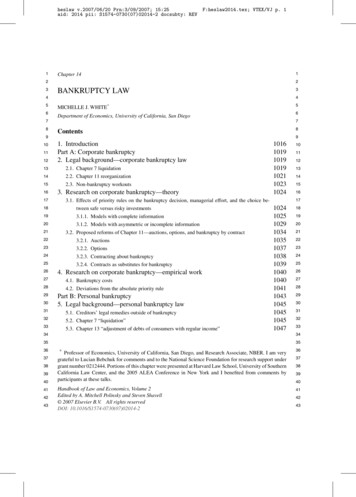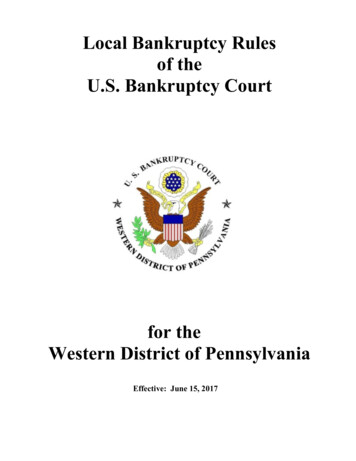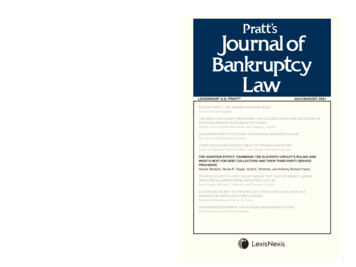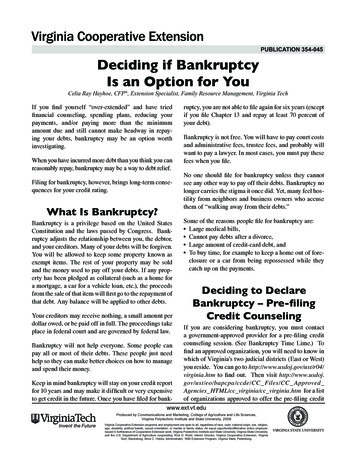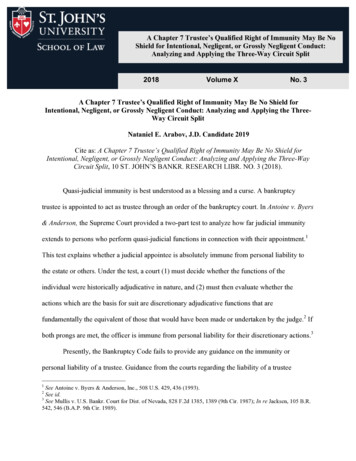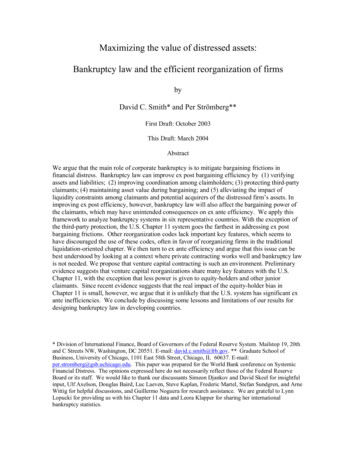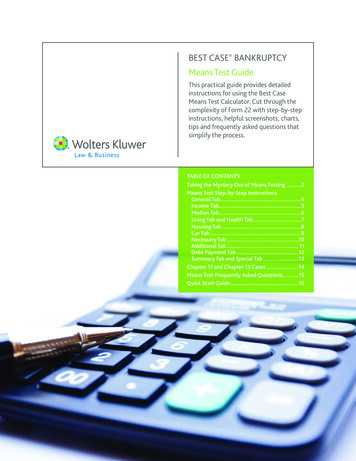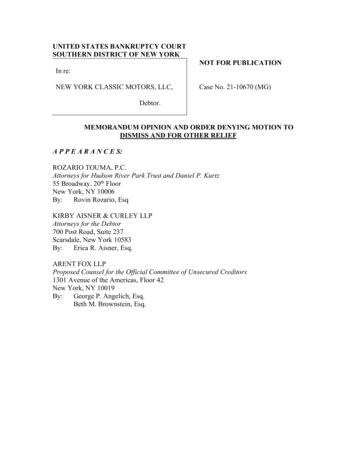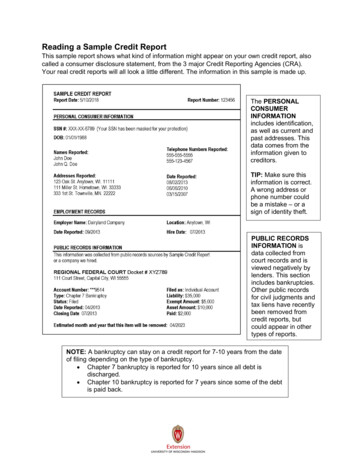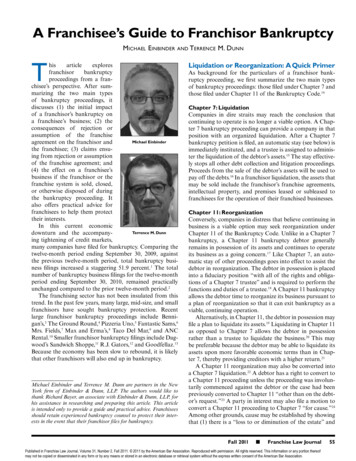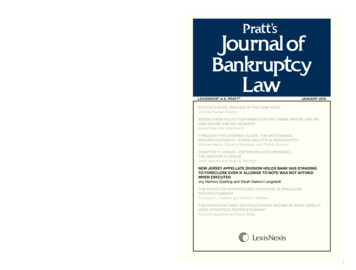
Transcription
PC / Ivory Vellum Carnival 35x23 / 80PRATT’S JOURNAL OF BANKRUPTCY LAWLEXISNEXIS A.S. PRATT JANUARY 2016EDITOR’S NOTE: RINGING IN THE NEW YEAR!Victoria Prussen SpearsVOLUME 12 NUMBER 1RESOLUTION POLICY FOR BANK-CENTRIC FIRMS: WHERE ARE WEAND WHERE ARE WE HEADED?Bimal Patel and Todd ArenaTHROUGH THE LOOKING GLASS: THE MECHANICALMISAPPLICATION OF IN PARI DELICTO IN BANKRUPTCYMichael Napoli, Eduardo Espinosa, and Patrick StantonCHAPTER 11 VENUE—DEFENDING (OR UPENDING)THE DEBTOR’S CHOICEJane VanLare and Hugh K. MurtaghNEW JERSEY APPELLATE DIVISION HOLDS BANK HAS STANDINGTO FORECLOSE EVEN IF ALLONGE TO NOTE WAS NOT AFFIXEDWHEN EXECUTEDJoy Harmon Sperling and Sarah Sakson LangstedtJANUARY 2016THE FIGHT FOR BONDHOLDER SUFFRAGE IN BRAZILIANRESTRUCTURINGSFrancisco L. Cestero and Daniel J. SoltmanTHE STRATEGIC DEBT RESTRUCTURING REGIME IN INDIA: DOES ITNEED STRATEGIC RESTRUCTURING?Pravesh Aggarwal and Rahul Bajaj
QUESTIONS ABOUT THIS PUBLICATION?For questions about the Editorial Content appearing in these volumes or reprint permission,please call:Kent K. B. Hanson, J.D. at . 415-908-3207Email: . kent.hanson@lexisnexis.comFor assistance with replacement pages, shipments, billing or other customer service matters,please call:Customer Services Department at . . . . . . . . . . . . . . . . . . . . . . . . . . . (800) 833-9844Outside the United States and Canada, please call . . . . . . . . . . . . . . . . (518) 487-3000Fax Number . . . . . . . . . . . . . . . . . . . . . . . . . . . . . . . . . . . . . . . . (518) 487-3584Customer Service Web site . . . . . . . . . . . . . . . . . . . http://www.lexisnexis.com/custserv/For information on other Matthew Bender publications, please callYour account manager or . . . . . . . . . . . . . . . . . . . . . . . . . . . . . . . . (800) 223-1940Outside the United States and Canada, please call . . . . . . . . . . . . . . . . . (518) 487-3000Library of Congress Card Number: 80-68780ISBN: 978-0-7698-7846-1 (print)ISBN: 978-0-7698-7988-8 (eBook)ISSN: 1931-6992Cite this publication as:[author name], [article title], [vol. no.] PRATT’S JOURNAL OF BANKRUPTCY LAW [page number]([year])Example: Patrick E. Mears, The Winds of Change Intensify over Europe: Recent European UnionActions Firmly Embrace the “Rescue and Recovery” Culture for Business Recovery, 10 PRATT’S JOURNALOF BANKRUPTCY LAW 349 (2014)This publication is sold with the understanding that the publisher is not engaged in rendering legal,accounting, or other professional services. If legal advice or other expert assistance is required, the services ofa competent professional should be sought.LexisNexis and the Knowledge Burst logo are registered trademarks of Reed Elsevier Properties Inc., usedunder license. A.S. Pratt is a registered trademark of Reed Elsevier Properties SA, used under license.Copyright 2016 Reed Elsevier Properties SA, used under license by Matthew Bender & Company, Inc.All Rights Reserved.No copyright is claimed by LexisNexis, Matthew Bender & Company, Inc., or Reed Elsevier Properties SA,in the text of statutes, regulations, and excerpts from court opinions quoted within this work. Permission tocopy material may be licensed for a fee from the Copyright Clearance Center, 222 Rosewood Drive, Danvers,Mass. 01923, telephone (978) 750-8400.An A.S. Pratt PublicationEditorial Offices630 Central Ave., New Providence, NJ 07974 (908) 464-6800201 Mission St., San Francisco, CA 94105-1831 (415) 908-3200www.lexisnexis.com(2016-Pub.4789)
Editor-in-Chief, Editor & Board ofEditorsEDITOR-IN-CHIEFSTEVEN A. MEYEROWITZPresident, Meyerowitz Communications Inc.EDITORVICTORIA PRUSSEN SPEARSSenior Vice President, Meyerowitz Communications Inc.BOARD OF EDITORSScott L. BaenaBilzin Sumberg BaenaPrice & Axelrod LLPThomas W. CoffeyTucker Ellis & West LLPLeslie A. BerkoffMoritt Hock & HamroffLLPMichael L. CookPatrick E. MearsSchulte Roth & Zabel LLP Barnes & Thornburg LLPTed A. BerkowitzFarrell Fritz, P.C.Mark G. DouglasJones DayAlec P. OstrowStevens & Lee P.C.Michael L. BernsteinArnold & Porter LLPTimothy P. DugganStark & StarkDeryck A. PalmerPillsbury Winthrop ShawPittman LLPAndrew P. BrozmanClifford Chance US LLPGregg M. FicksCoblentz, Patch, Duffy &Bass LLPN. Theodore Zink, Jr.Chadbourne & Parke LLPKevin H. BuraksPortnoff Law Associates,Ltd.Mark J. FriedmanDLA PiperPeter S. Clark IIReed Smith LLPRobin E. KellerLovellsMatthew W. LevinAlston & Bird LLPPRATT’S JOURNAL OF BANKRUPTCY LAW is published eight times a year by MatthewBender & Company, Inc. Copyright 2016 Reed Elsevier Properties SA., used under license byMatthew Bender & Company, Inc. All rights reserved. No part of this journal may be reproducedin any form—by microfilm, xerography, or otherwise—or incorporated into any informationretrieval system without the written permission of the copyright owner. For permission tophotocopy or use material electronically from Pratt’s Journal of Bankruptcy Law, please accessiii
www.copyright.com or contact the Copyright Clearance Center, Inc. (CCC), 222 RosewoodDrive, Danvers, MA 01923, 978-750-8400. CCC is a not-for-profit organization that provideslicenses and registration for a variety of users. For subscription information and customer service,call 1-800-833-9844.Direct any editorial inquires and send any material for publication to Steven A. Meyerowitz,Editor-in-Chief, Meyerowitz Communications Inc., 26910 Grand Central Parkway, No. 18R,Floral Park, NY 11005, smeyerowitz@meyerowitzcommunications.com, 718.224.2258. Materialfor publication is welcomed—articles, decisions, or other items of interest to bankers, officers offinancial institutions, and their attorneys. This publication is designed to be accurate andauthoritative, but neither the publisher nor the authors are rendering legal, accounting, or otherprofessional services in this publication. If legal or other expert advice is desired, retain theservices of an appropriate professional. The articles and columns reflect only the presentconsiderations and views of the authors and do not necessarily reflect those of the firms ororganizations with which they are affiliated, any of the former or present clients of the authorsor their firms or organizations, or the editors or publisher. POSTMASTER: Send address changesto Pratt’s Journal of Bankruptcy Law, LexisNexis Matthew Bender, 630 Central Avenue, NewProvidence, NJ 07974.iv
PRATT’S JOURNALOFBANKRUPTCY LAWNew Jersey Appellate Division Holds BankHas Standing to Foreclose Even If Allonge toNote Was Not Affixed When ExecutedBy Joy Harmon Sperling and Sarah Sakson Langstedt*The New Jersey Appellate Division recently ruled that the plaintiff in acommercial foreclosure action had established a prima facie case forforeclosure even though the allonge to the note was not physically attachedwhen the allonge was initially executed. The authors of this article discussthe decision.In an opinion that should assist lenders in establishing standing to foreclose,the New Jersey Appellate Division ruled that the plaintiff in a commercialforeclosure action had established a prima facie case for foreclosure even thoughthe allonge to the note was not physically attached when the allonge wasinitially executed. In U.S. Bank National Association v. Morris Bayonne AssociatesI, LLC,1 an unpublished decision, the court upheld the trial court’s granting ofsummary and final judgment for foreclosure in favor of U.S. Bank afterdetermining that U.S. Bank had adequately proven its standing to foreclose.THE FACTSThe facts in the case were straightforward. In 2007, three LLCs entered intoa loan agreement and executed a promissory note and a mortgage oncommercial property in favor of Countrywide Real Estate Finance, Inc. Twoindividuals guaranteed the note. The LLCs also executed an assignment of rentsand leases and a security agreement and fixture filing to secure the loan. Thenote, mortgage, and all loan documents were assigned first from Countrywideto LaSalle Bank, National Association, and then to U.S. Bank. The mortgageand assignments were properly recorded.When the loan documents were assigned to U.S. Bank, the allonge indorsingthe note was not attached to the note. In anticipation of foreclosing on the loan,due to the borrowers’ defaults, the special servicer for U.S. Bank requestedpermission from U.S. Bank to attach the allonge to the note. This request was*Joy Harmon Sperling, a partner at Day Pitney LLP and chair of the firm’s Creditors’ Rightsand Real Estate Litigation practice group, primarily represents consumer lending institutions inthe defense of claims by borrowers in individual and class-action claims. Sarah Sakson Langstedtis an associate in the firm’s Commercial Litigation department. The authors may be reached atjsperling@daypitney.com and slangstedt@daypitney.com, respectively.1No. A-2279-13 (App. Div. Sept. 9, 2015).34
NEW JERSEY DECISIONONBANK’S STANDING TO FORECLOSEmade four years after the loan was assigned, which request was granted by U.S.Bank. Eight days later, in September 2012, U.S. Bank commenced theforeclosure action.Shortly after filing its action, U.S. Bank filed a motion for summaryjudgment. In support of the motion, U.S. Bank submitted certifications andaffidavits from two employees of the special servicer for U.S. Bank. In opposingthe motion, defendants argued that U.S. Bank had not established itsownership of the note and raised issues as to the affidavits and certificationssubmitted. However, defendants did not contest their execution of the loandocuments, their default, or that foreclosure was an available remedy afterdefault.2THE TRIAL COURT’S DECISIONThe trial court allowed defendants to depose the employees of the servicerand adjourned the motion. One of the employees was unavailable as he wasoverseas for an extended period, but defendants did not request additional timeto depose him. After completing the deposition of the one employee,defendants again opposed the motion for summary judgment, contending thatthere were genuine issues of material fact as to the standing of U.S. Bank. Inrejecting the opposition, and granting U.S. Bank’s motion, the trial court foundthere were no disputed issues of material fact that would preclude summaryjudgment and ruled that U.S. Bank had established a prima facie case forforeclosure. Thereafter, final judgment was entered in favor of U.S. Bank, anddefendants filed an appeal.THE APPEALIn their appeal, defendants again argued that there was a genuine issue ofmaterial fact regarding U.S. Bank’s ownership of the note. Specifically,defendants claimed that, because the allonge was not originally attached to thenote, the foreclosing entity did not have standing to foreclose.3 They furtheralleged that the deposition testimony of the servicer’s employee conflicted withhis affidavits, and questioned his personal knowledge.As to defendants’ arguments and contentions regarding the proofs submitted2A few months before the filing of the foreclosure complaint, U.S. Bank, the special servicer,and defendants entered into a pre-negotiation agreement. In the pre-negotiation agreement,defendants admitted their default and U.S. Bank’s status as the holder of the loan.3At oral argument before the Appellate Division, defendants conceded that an allonge neednot be attached to the note as long as it is properly authenticated.35
PRATT ’S JOURNALOFBANKRUPTCY LAWby U.S. Bank through the special servicer’s employees, the Appellate Divisionrejected those claims. As to defendants’ arguments regarding the production ofonly one employee for a deposition, the court found that U.S. Bank wasentitled to produce the one employee, especially considering the other employeewas overseas. The court noted that defendants had not requested more time todepose the other employee and did not ask the trial court to find that theproduction of the employee with less knowledge was in bad faith.As to defendants’ contentions regarding the alleged inconsistencies betweenthe testimony and affidavits of the deposed employee, the court noted thatdefendants had not refuted the facts regarding the transfer of the loan with anyof their own evidence. Moreover, the court did not find the inconsistenciessufficient to find an abuse of discretion on the part of the trial judge in relyingon the affidavits.The Appellate Division also addressed the issues raised concerning theadmission of business records. Regarding defendants’ assertion that theservicer’s employees did not have sufficient personal knowledge, the court heldthat employees of the mortgage loan servicer could attest to the business recordskept in the regular course of their business. In so doing, the court, relying onthe rules of evidence and prior case law, noted that: “There is no requirementthat the foundation witness certifying that a record is a business record mustpossess any personal knowledge of the act or event recorded.”4 The court foundthat the servicer’s employees’ knowledge of the computer system that maintained the servicer’s files was adequate to authenticate the business records.Importantly, with regard to standing, the Appellate Division agreed with thetrial court that U.S. Bank was the holder of the note, as defined by Article IIIof New Jersey’s Uniform Commercial Code. As the court observed, the allongeclearly identified the note, confirmed the prior holders, confirmed U.S. Bank asthe new holder and, therefore, ownership of the note by the plaintiff was notin question. The court opined that defendants could not point to any bindingauthority to establish that the attachment of the allonge to the note prior to thefiling of the complaint (as compared to at the time the allonge was executed)is insufficient to show that the note was not properly assigned or indorsed.The court also found that, because the mortgage and related loan documentshad been assigned to U.S. Bank prior to the filing of the foreclosure complaint,U.S. Bank had standing, in accordance with New Jersey case law and theUniform Commercial Code.4Citations omitted.36
NEW JERSEY DECISIONONBANK’S STANDING TO FORECLOSECONCLUSIONThe decision in Morris Bayonne Associates recognizes the realities of how loansare transferred and that, when a foreclosing entity provides sufficient proof ofstanding, objections by borrowers, which have no support in the documents,should be rejected. In this case, although the allonge was not initially attachedto the note, the proofs showed that U.S. Bank had been properly assigned theloan and had the right to foreclose. Although nothing in the decision indicatesthat the holding is limited to commercial foreclosures, lenders will undoubtedlyhope that it is applied to residential foreclosure actions as well.37
TT'S JOURNAL OF BANKRUPTCY LAW PC / Ivory Vellum Carnival 35x23 / 80 LEXISNEXIS A.S. PRATT JANUARY 2016 EDITOR'S NOTE: RINGING IN THE NEW YEAR! Victoria Prussen Spears RESOLUTION POLICY FOR BANK-CENTRIC FIRMS: WHERE ARE WE AND WHERE ARE WE HEADED? Bimal Patel and Todd Arena THROUGH THE LOOKING GLASS: THE MECHANICAL

